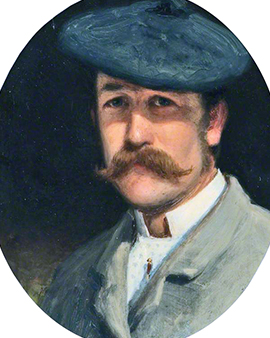The Scottish painter Joseph Farquharson is still appreciated today for his snowy landscapes. He depicted them atmospherically in warm morning or evening light. He often chose the surroundings of his birthplace as a motif for his paintings. The artist grew up in an idyllic rural area in the north-east of Scotland on his family's estate. His father was a doctor and Laird of Finzean. As a Scottish landowner he belonged to the landed gentry with feudal rights. Land ownership and nobility titles were later inherited by his son Joseph Farquharson. At times Joseph received lessons from the Scottish landscape painter Peter Graham. He became a friend for many years. Graham's works inspired Joseph Farquharson throughout his artistic career. During his time at the Edinburgh Trustees Academy and the Life Schools of the Royal Academy of Arts he learned important painting and drawing techniques and dealt with artistic themes. His first major exhibition took place there in 1873. In 1915 he became a member of the Royal Academy of Arts.
He mainly painted oil paintings and watercolours. He had consciously chosen London as the place for his artistic work. He hoped to reach a wider public with his works there. His works of art have a special aesthetic without renouncing tension and realism. The landscapes of perfect beauty were inspired by the rural environment in which he grew up. Snow scenes show the idyllic landscape in a special light atmosphere. The artist was a master in bringing warm and pleasant lighting moods in all their facets to canvas. He often worked outdoors. Thus he had an unobstructed view of the motif and the individual lighting mood. The harsh Scottish climate made working outside a challenge. But Farquharson had an idea and built a small painting hut on wheels. Through the large glass window he looked directly at the picturesque landscapes around his home.
Around 1800 he spent a period in Paris to study with his artist colleague Charles Auguste Émile Durand. The time there changed Farquharson's style. Durand taught his students to think in form and color. From then on, a greater variety of colors was found in Farquharson's works. From 1885 the artist spent eight years in North Africa. During this time he created outstanding works with North African desert views, which unfortunately have been somewhat forgotten today. The artist chose the titles of his works from poems by Milton, Burns or Shakespeare. In 1935 e died on the estate of his family. His paintings can be seen in many museums today. One of his paintings only appeared in 2008. A homeowner bought a work by the artist from 1901 for 1,450 pounds and the owner decided to sell the house. There was no room for the painting in the new flat, so it was sold at an art auction. The painting fetched £70,000.
×





.jpg)
.jpg)
_-_(MeisterDrucke-902091).jpg)
_-_(MeisterDrucke-902091).jpg)
.jpg)
.jpg)
.jpg)
.jpg)
.jpg)
.jpg)
.jpg)
.jpg)
.jpg)
.jpg)
.jpg)
.jpg)
_-_(MeisterDrucke-1315179).jpg)
_-_(MeisterDrucke-1315179).jpg)
.jpg)
.jpg)
.jpg)
.jpg)
.jpg)
.jpg)
.jpg)
.jpg)
.jpg)
.jpg)
.jpg)
.jpg)
.jpg)
.jpg)
.jpg)
.jpg)
.jpg)
.jpg)
.jpg)
.jpg)
.jpg)
.jpg)
.jpg)
.jpg)
.jpg)
.jpg)
_-_(MeisterDrucke-1174118).jpg)
_-_(MeisterDrucke-1174118).jpg)
.jpg)
.jpg)
.jpg)
.jpg)
_-_(MeisterDrucke-1171182).jpg)
_-_(MeisterDrucke-1171182).jpg)
.jpg)
.jpg)
.jpg)
.jpg)
.jpg)
.jpg)
.jpg)
.jpg)
.jpg)
.jpg)
_-_(MeisterDrucke-1465736).jpg)
_-_(MeisterDrucke-1465736).jpg)
.jpg)
.jpg)
.jpg)
.jpg)
.jpg)
.jpg)
.jpg)
.jpg)
_-_(MeisterDrucke-908742).jpg)
_-_(MeisterDrucke-908742).jpg)
.jpg)
.jpg)
.jpg)
.jpg)
.jpg)
.jpg)
_-_(MeisterDrucke-975776).jpg)
_-_(MeisterDrucke-975776).jpg)






